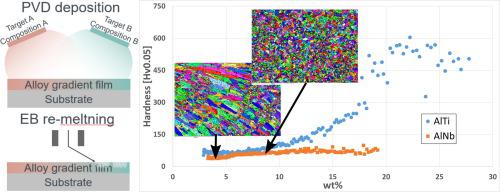Materials & Design ( IF 8.4 ) Pub Date : 2021-09-27 , DOI: 10.1016/j.matdes.2021.110129 Freddy Leijon 1, 2 , Sebastian Wachter 3 , Zongwen Fu 3 , Carolin Körner 3 , Svein Skjervold 1 , Johan Moverare 2

|
Powder bed fusion (PBF) methods offer the best material properties among metal additive manufacturing (AM) processes. Yet, alloy development for PBF is only at its infancy and has a great untapped potential. This originates from the high solidification rate within the melt pool and to exploit the full potential of materials produced by PBF methods, a diligent work lies ahead. This paper presents a high-throughput method to rapidly screen large compositional alloy intervals experimentally for their PBF feasibility, which can drastically reduce the time needed for alloy development and provide valuable data for modelling. Our method consists of two steps; co-sputtering and electron beam re-melting. First step produces an alloy gradient film on a sheet substrate. The film is then re-molted to produce a PBF mimicked microstructure. The method is successfully demonstrated on binary systems; Al -Ti, -Zr and -Nb and produced gradients in compositional ranges of 3–50 wt%Ti, 1–15 wt%Zr and 2–15 wt%Nb over a length of 200 mm. From the produced materials, the alloying efficiency could be investigated and determined regarding hardness and grain refinement. Zr shows the highest strength contribution per at% and the best grain refinement at low levels. However, at higher levels grain refinement efficiency decreases for Zr.
中文翻译:

一种用于粉末床增材制造的新型合金快速开发方法,用于二元 Al-Ti、-Zr 和 -Nb 合金
粉末床融合 (PBF) 方法在金属增材制造 (AM) 工艺中提供了最佳的材料特性。然而,PBF 的合金开发还处于起步阶段,具有巨大的未开发潜力。这源于熔池内的高凝固率,要充分发挥 PBF 方法生产的材料的潜力,还有一项艰巨的工作。本文提出了一种高通量方法,通过实验快速筛选大成分合金区间的 PBF 可行性,这可以大大减少合金开发所需的时间,并为建模提供有价值的数据。我们的方法包括两个步骤;共溅射和电子束重熔。第一步在片状基材上产生合金梯度膜。然后将薄膜重新熔化以产生 PBF 模拟微结构。该方法已在二进制系统上成功演示;Al -Ti、-Zr 和 -Nb 并在 200 毫米的长度上产生 3–50 wt% Ti、1–15 wt% Zr 和 2–15 wt% Nb 的成分梯度。从生产的材料中,可以研究和确定关于硬度和晶粒细化的合金化效率。Zr 显示出最高的每原子百分比强度贡献和最好的晶粒细化在低水平下。然而,在较高水平下,Zr 的晶粒细化效率会降低。Zr 显示出最高的每原子百分比强度贡献和最好的晶粒细化在低水平下。然而,在较高水平下,Zr 的晶粒细化效率会降低。Zr 显示出最高的每原子百分比强度贡献和最好的晶粒细化在低水平下。然而,在较高水平下,Zr 的晶粒细化效率会降低。


























 京公网安备 11010802027423号
京公网安备 11010802027423号